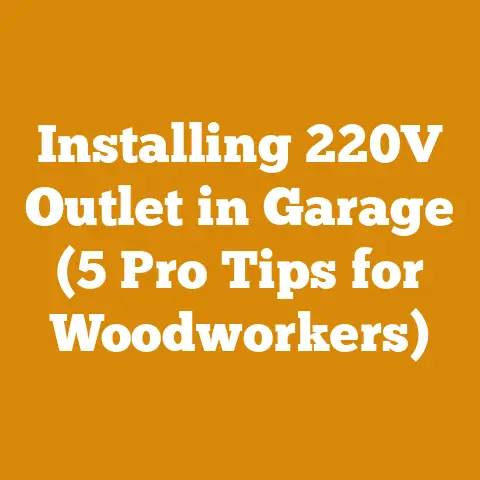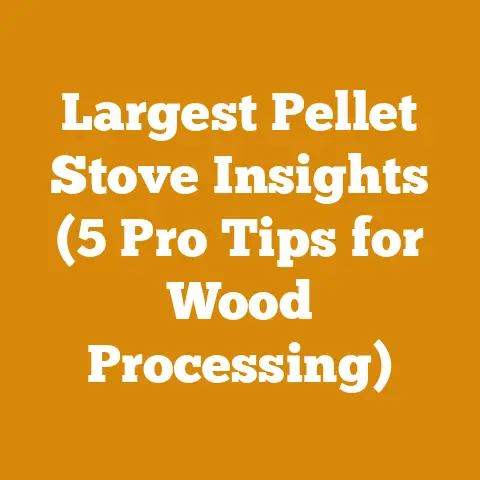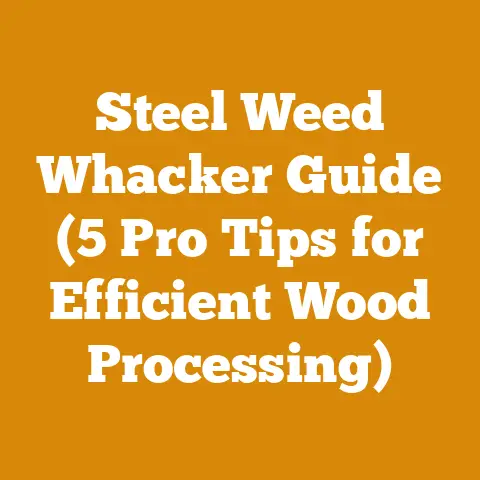How Do You Clean a Chimney Flue? (Pro Tips for Woodburners)
Why a Clean Chimney Flue Matters: My Own Close Call
Let me start with a story. A few years back, I got complacent about my chimney cleaning. “It’s just been a mild winter,” I told myself. Big mistake. One cold evening, I had a roaring fire going when I noticed a strange smell. Then, I saw it – smoke billowing out from around the stovepipe. Creosote buildup had ignited in the chimney. I managed to extinguish the fire quickly, but it was a wake-up call. That incident taught me a valuable lesson: a clean chimney is a safe chimney. Now, I’m meticulous about maintenance, and I want to help you avoid a similar scare.
Understanding Chimney Flue Functionality
The chimney flue is the passageway that vents smoke and combustion byproducts from your fireplace or wood stove to the outside. It’s a critical component of your heating system, ensuring that harmful gases like carbon monoxide are safely expelled from your home.
The Dangers of Creosote Buildup
Creosote is a byproduct of burning wood. It’s a black or brown residue that accumulates inside your chimney flue. It’s highly flammable, and that’s where the danger lies.
- Stages of Creosote: Creosote forms in stages. Stage one is a light, flaky soot. Stage two is a more tar-like substance. Stage three is a hard, glazed coating that’s extremely difficult to remove.
- Fire Hazard: Creosote is the primary cause of chimney fires. Even a small amount can ignite under the right conditions.
- Reduced Efficiency: Creosote buildup restricts airflow, making your fireplace or wood stove less efficient. This means you’ll burn more wood to get the same amount of heat.
- Carbon Monoxide Poisoning: A blocked chimney can cause carbon monoxide to back up into your home, posing a serious health risk.
Identifying the Need for Cleaning
Here are some telltale signs that your chimney needs a cleaning:
- Visible Creosote: Inspect your chimney flue with a flashlight. If you see a significant buildup of creosote, it’s time to clean.
- Restricted Draft: If your fireplace or wood stove is difficult to light or smokes back into the room, your chimney may be blocked by creosote.
- Strange Odors: A strong, smoky odor, even when the fireplace isn’t in use, can indicate creosote buildup.
- Falling Debris: If you notice chunks of creosote falling into your fireplace, it’s a clear sign of a problem.
How Often Should You Clean Your Chimney?
The National Fire Protection Association (NFPA) recommends that you have your chimney inspected at least once a year. If you burn wood regularly, you may need to clean it more often.
- General Guideline: If you burn a cord or more of wood per year, consider cleaning your chimney twice a year – once before the heating season and once after.
- Wood Type Matters: Burning softwoods like pine tends to produce more creosote than hardwoods like oak or maple. If you burn a lot of softwood, you’ll need to clean your chimney more frequently.
- Burning Habits: Burning unseasoned wood or burning fires at low temperatures (smoldering fires) also increases creosote buildup.
Safety First: Preparing for the Cleaning Process
Before you even think about grabbing your cleaning tools, let’s talk safety. Cleaning a chimney can be a dirty and potentially dangerous job.
- Personal Protective Equipment (PPE):
- Respirator: A properly fitted N95 or P100 respirator is essential to protect your lungs from dust and creosote particles.
- Eye Protection: Wear safety glasses or goggles to prevent debris from getting in your eyes.
- Gloves: Heavy-duty work gloves will protect your hands from abrasions and chemicals.
- Old Clothes: Wear clothes that you don’t mind getting dirty. A long-sleeved shirt and pants are recommended.
- Protecting Your Home:
- Drop Cloths: Cover the area around your fireplace or wood stove with drop cloths to protect your flooring.
- Sealing the Fireplace: Use plastic sheeting and painter’s tape to seal off the fireplace opening. This will prevent soot and debris from escaping into your home.
Essential Tools for Chimney Cleaning
Having the right tools makes the job much easier and more effective. Here’s a list of what you’ll need:
- Chimney Brush: This is the most important tool. Choose a brush that’s the correct size and shape for your chimney flue.
- Round Brush: For round chimney flues.
- Square Brush: For square or rectangular chimney flues.
- Wire Brush: For masonry chimneys.
- Poly Brush: For metal chimney liners.
- Sizing: Measure the inside diameter or dimensions of your flue to ensure a proper fit. A brush that’s too small won’t clean effectively, and one that’s too large will be difficult to push through.
- Extension Rods: These connect to the chimney brush and allow you to reach the full length of the flue.
- Material: Fiberglass or polypropylene rods are durable and flexible.
- Length: Choose rods that are long enough to reach the top of your chimney.
- Connection: Make sure the rods have a secure connection system to prevent them from coming apart inside the chimney.
- Weight (Optional): A weight attached to the brush can help it descend through the chimney, especially if you’re cleaning from the top down.
- Flashlight: A bright flashlight is essential for inspecting the chimney flue.
- Shop Vacuum: A shop vacuum with a HEPA filter is ideal for cleaning up soot and debris.
- Scraper: A metal scraper can be used to remove stubborn creosote deposits.
- Mirror: A small mirror can be helpful for inspecting hard-to-reach areas of the chimney.
- Ladder (If Cleaning from the Top): A sturdy ladder is necessary for accessing the chimney from the roof.
Step-by-Step Guide: Cleaning Your Chimney Flue from the Bottom Up
This method involves cleaning the chimney from inside your house, using the fireplace opening.
- Preparation:
- Put on your PPE (respirator, eye protection, gloves, old clothes).
- Cover the area around your fireplace with drop cloths.
- Seal off the fireplace opening with plastic sheeting and painter’s tape.
- Accessing the Flue:
- Carefully remove the damper. Some dampers can be easily removed, while others may require some disassembly. Consult your fireplace manual for instructions.
- Assembling the Brush and Rods:
- Attach the chimney brush to the first extension rod.
- Feed the brush up into the flue, pushing it as far as it will go.
- Cleaning the Flue:
- Use a back-and-forth scrubbing motion to clean the flue walls.
- Add additional extension rods as needed to reach the top of the chimney.
- Pay close attention to areas with heavy creosote buildup.
- Removing the Brush:
- Once you’ve reached the top of the chimney, slowly pull the brush back down, continuing to scrub the flue walls.
- Remove the extension rods one at a time as you lower the brush.
- Cleaning the Firebox:
- Use a shop vacuum to clean out the firebox, removing any remaining soot and debris.
- Scrape off any creosote deposits from the firebox walls.
- Reinstalling the Damper:
- Carefully reinstall the damper, following the manufacturer’s instructions.
- Cleaning Up:
- Remove the plastic sheeting and drop cloths.
- Vacuum the area around the fireplace to remove any remaining soot and debris.
- Dispose of the used plastic sheeting and drop cloths properly.
Step-by-Step Guide: Cleaning Your Chimney Flue from the Top Down
This method involves cleaning the chimney from the roof. It’s often more effective for removing heavy creosote buildup, but it also requires more caution.
- Safety First:
- Ladder Safety: Use a sturdy ladder and follow all safety precautions. Have someone spot you while you’re on the ladder.
- Roof Safety: Wear shoes with good traction and be aware of weather conditions. Avoid cleaning your chimney on windy or icy days.
- Preparation:
- Put on your PPE (respirator, eye protection, gloves, old clothes).
- Cover the area around your fireplace with drop cloths inside the house.
- Seal off the fireplace opening with plastic sheeting and painter’s tape.
- Accessing the Chimney:
- Carefully climb onto the roof and approach the chimney.
- Inspect the chimney for any damage or hazards.
- Assembling the Brush and Rods:
- Attach the chimney brush to the first extension rod.
- If using a weight, attach it to the bottom of the brush.
- Cleaning the Flue:
- Lower the brush into the flue, allowing the weight to pull it down.
- Use a back-and-forth scrubbing motion to clean the flue walls.
- Add additional extension rods as needed to reach the bottom of the chimney.
- Pay close attention to areas with heavy creosote buildup.
- Removing the Brush:
- Once you’ve reached the bottom of the chimney, slowly pull the brush back up, continuing to scrub the flue walls.
- Remove the extension rods one at a time as you raise the brush.
- Cleaning the Chimney Crown:
- Use a brush or scraper to clean the chimney crown (the top of the chimney) of any debris.
- Cleaning Up:
- Carefully climb back down the ladder.
- Remove the plastic sheeting and drop cloths inside the house.
- Vacuum the area around the fireplace to remove any remaining soot and debris.
- Dispose of the used plastic sheeting and drop cloths properly.
Dealing with Stubborn Creosote
Sometimes, creosote buildup is so thick and hardened that a standard chimney brush won’t do the trick. Here are some techniques for dealing with stubborn creosote:
- Creosote Removal Chemicals: There are several chemical creosote removers available on the market. These products are designed to break down creosote, making it easier to remove.
- Application: Follow the manufacturer’s instructions carefully. Some products are sprayed into the firebox, while others are burned in the fireplace.
- Effectiveness: Chemical creosote removers can be effective for loosening creosote, but they may not completely remove it.
- Safety: Always wear appropriate PPE when using chemical creosote removers.
- Rotary Chimney Cleaning Tools: These power tools use a rotating brush head to aggressively scrub the chimney flue.
- Operation: Rotary chimney cleaning tools are attached to a drill or power driver. The rotating brush head can quickly remove even the most stubborn creosote deposits.
- Cost: Rotary chimney cleaning tools can be expensive, but they’re a worthwhile investment if you have a lot of creosote buildup.
- Professional Use: These are generally best used by professionals, but if you are experienced with power tools and comfortable on a ladder, you can safely use them yourself.
- Professional Chimney Sweep: If you’re unable to remove the creosote yourself, it’s best to call a professional chimney sweep. They have the tools and expertise to safely and effectively clean your chimney.
Inspecting Your Chimney After Cleaning
After cleaning your chimney, it’s important to inspect it for any damage or potential problems.
- Cracks or Damage: Look for cracks or damage in the chimney flue, firebox, and chimney crown.
- Loose Bricks or Mortar: Check for loose bricks or mortar joints.
- Water Damage: Inspect for signs of water damage, such as stains or discoloration.
- Animal Nests: Look for signs of animal nests, such as twigs or droppings.
Maintenance Tips for a Cleaner Chimney
Here are some tips to help you keep your chimney cleaner and reduce creosote buildup:
- Burn Seasoned Wood: Seasoned wood burns hotter and cleaner than unseasoned wood. Aim for a moisture content of 20% or less.
- Seasoning Process: Stack your wood in a sunny, well-ventilated area for at least six months to a year.
- Moisture Meter: Use a moisture meter to check the moisture content of your wood.
- Burn Hot Fires: Burning hot fires helps to prevent creosote buildup. Avoid smoldering fires, which produce more smoke and creosote.
- Choose the Right Wood: Hardwoods like oak, maple, and ash produce less creosote than softwoods like pine and fir.
- Hardwood vs. Softwood: Hardwoods are denser and burn longer, producing more heat and less smoke.
- Regular Inspections: Have your chimney inspected at least once a year by a qualified chimney sweep.
- Proper Airflow: Make sure your fireplace or wood stove has adequate airflow. This will help to ensure complete combustion and reduce creosote buildup.
- Avoid Burning Trash: Never burn trash, cardboard, or other materials in your fireplace or wood stove. These materials can produce harmful chemicals and increase creosote buildup.
When to Call a Professional Chimney Sweep
While you can clean your chimney yourself, there are times when it’s best to call a professional chimney sweep.
- Heavy Creosote Buildup: If you have a significant amount of creosote buildup that you can’t remove yourself, a professional chimney sweep has the tools and expertise to get the job done.
- Chimney Damage: If you notice any damage to your chimney, such as cracks or loose bricks, a professional chimney sweep can assess the damage and recommend repairs.
- Complex Chimney Systems: If you have a complex chimney system, such as one with multiple flues or offsets, it’s best to hire a professional chimney sweep who is familiar with these types of systems.
- Peace of Mind: Even if you’re comfortable cleaning your chimney yourself, hiring a professional chimney sweep can give you peace of mind knowing that the job has been done correctly and safely.
Cost of Professional Chimney Cleaning
The cost of professional chimney cleaning can vary depending on several factors, including:
- Location: Prices may vary depending on your geographic location.
- Chimney Height: Taller chimneys may cost more to clean.
- Creosote Buildup: Heavily creosote-laden chimneys may require more time and effort to clean, increasing the cost.
- Additional Services: Additional services, such as chimney inspections or repairs, will add to the overall cost.
Average Cost: On average, professional chimney cleaning costs between $150 and $300.
Chimney Inspections: A Deeper Dive
A chimney inspection is a thorough examination of your chimney system, including the flue, firebox, and chimney crown. There are three levels of chimney inspections:
- Types of Chimney Liners:
- Clay Tile Liners: These are the most common type of chimney liner. They’re durable and relatively inexpensive, but they can crack over time.
- Metal Liners: These are made of stainless steel or aluminum. They’re more expensive than clay tile liners, but they’re more durable and resistant to corrosion.
- Cast-in-Place Liners: These are made of a cement-like material that is poured into the chimney flue. They’re very durable and can seal cracks in the chimney.
- When to Replace a Chimney Liner:
- Cracks or Damage: If your chimney liner is cracked or damaged, it needs to be replaced.
- Improper Sizing: If your chimney liner is not the correct size for your heating appliance, it needs to be replaced.
- Corrosion: If your metal chimney liner is corroded, it needs to be replaced.
Understanding Wood Moisture Content
I mentioned the importance of burning seasoned wood, and that brings us to moisture content. The ideal moisture content for firewood is 20% or less.
- Why Moisture Content Matters:
- Efficiency: Dry wood burns more efficiently, producing more heat and less smoke.
- Creosote Reduction: Dry wood produces less creosote than wet wood.
- Ease of Lighting: Dry wood is easier to light than wet wood.
- Measuring Moisture Content:
- Moisture Meter: A moisture meter is the most accurate way to measure the moisture content of wood. Insert the probes into a freshly split piece of wood to get a reading.
- Visual Inspection: You can also get a rough estimate of moisture content by visually inspecting the wood. Dry wood will be lighter in color and have cracks in the end grain.
The Importance of Proper Wood Storage
Even seasoned wood can reabsorb moisture if it’s not stored properly.
- Elevated Storage: Stack your wood on pallets or cinder blocks to keep it off the ground.
- Covered Storage: Cover your woodpile with a tarp or shed roof to protect it from rain and snow.
- Ventilation: Allow for adequate ventilation around your woodpile to promote drying.
- Sunlight: Stack your wood in a sunny location to help it dry faster.
Chimney Caps: Protecting Your Chimney from the Elements
A chimney cap is a mesh covering that sits on top of your chimney. It protects your chimney from rain, snow, and animals.
- Benefits of a Chimney Cap:
- Prevents Water Damage: A chimney cap prevents rain and snow from entering your chimney, which can cause water damage.
- Keeps Out Animals: A chimney cap prevents birds, squirrels, and other animals from nesting in your chimney.
- Prevents Downdrafts: A chimney cap can help to prevent downdrafts, which can cause smoke to back up into your home.
- Spark Arrestor: Some chimney caps have a spark arrestor, which prevents sparks from escaping the chimney and potentially starting a fire.
Alternative Chimney Cleaning Methods
While I’ve focused on traditional chimney cleaning methods, there are a few alternative techniques worth mentioning.
- Burning Creosote Logs: These logs contain chemicals that are designed to break down creosote buildup. They can be used as a supplement to traditional chimney cleaning, but they’re not a substitute for it.
- Top-Down Burning: This technique involves lighting the fire from the top down, rather than the bottom up. It can help to reduce creosote buildup by burning the wood more efficiently.
Common Mistakes to Avoid
Here are some common mistakes that people make when cleaning their chimneys:
- Using the Wrong Size Brush: Using a brush that’s too small or too large can damage your chimney flue.
- Not Wearing PPE: Failing to wear proper PPE can expose you to harmful dust and chemicals.
- Not Protecting Your Home: Failing to protect your home from soot and debris can create a mess.
- Ignoring Warning Signs: Ignoring warning signs of creosote buildup can lead to a chimney fire.
- Skipping Inspections: Skipping regular chimney inspections can allow problems to go undetected.
Final Thoughts: A Clean Chimney is a Safe Chimney
Cleaning your chimney flue is an essential part of maintaining a safe and efficient heating system. By following the tips and techniques outlined in this guide, you can keep your chimney in top condition and enjoy cozy, worry-free fires all winter long. Remember, if you’re ever unsure about any aspect of chimney cleaning or maintenance, don’t hesitate to call a professional chimney sweep. Your safety is always the top priority. Stay warm, stay safe, and happy burning!






